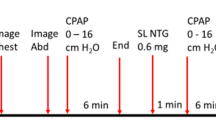Summary
-
1.
When sodium nitroprusside (SNP) was infused into the vascular beds of the hind-leg, the head, and the liver of the rat, the hypotensive responses were considerably reduced in comparison to i.v. infused SNP indicating an inactivation of SNP in these parts of the circulation. A mean extraction of 35.7%, and 27.6% of SNP during a single passage through the hind-leg and the liver, resp., was calculated. The pulmonary vascular bed did not diminish the hypotensive effect of SNP, however.
-
2.
Acute interruption of the renal circulation by ligation of the renal hili greatly enhanced the hypotensive response to SNP suggesting an inactivation in this vascular bed, too.
-
3.
A bioassay was developed for the detection of small amounts of SNP which was based on the recording of hypotensive responses of “recipient” rats to aliquots of blood containing unknown amounts of SNP.
-
4.
On infusion of 100 μg SNP/min, the SNP levels found in the blood of the abdominal aorta and the femoral vein were 13.5±1.2 and 9.7±1.0 μg SNP/ml (ݱS.E., n=7) resp., confirming the inactivation of SNP within the hind-leg circulation (mean extraction: 26.5%).
-
5.
The time-course of the SNP level in venous blood during, and after cessation of the infusion of 100 μg SNP/min for 20 min was followed thus permitting the calculation of several pharmacokinetic parameters of the SNP elimination from the central compartment.
-
6.
The in vivo half-life of elimination of SNP (4.7 min) was 10 times shorter than the half-life of SNP inactivation in rat blood in vitro. The volume of distribution of SNP corresponded to the extracellular space.
-
7.
The finding that the pulmonary vascular bed, in contrast to all other vascular beds studied, did not inactivate SNP, and the notion that the pulmonary capillaries are practically devoid of an extracellular space surrounding other capillaries, suggests that the site of the in vivo disposition for SNP is within the interstitial space.
Similar content being viewed by others
References
Casinelli CM (1956) La accion hipotensora del nitroprusiato aplicaciones terapéuticas. An Fac Med (Lima) 39:1330–1331
Desprez T, Dequiedt P, Cailler C, Vanhille P, Raviart B, Lelievre G, Tacquet A (1980) Technique de dosage sériques du nitroprussiate de sodium au cours de son utilisation dans le traitement des hypertensions malignes. Pathol Biol 28:335–340
Dost FH (1968) Grundlagen der Pharmakokinetik. Georg Thieme, Stuttgart
Edinburgh Pharmacology Department Staff (1970) Pharmacological experiments on isolated preparations. Livingstone Ltd, Edinburgh London
Forrest JB (1979) Structural aspects of gas exchange. Fed Proc 38:209–214
Hill HE (1942) A contribution to the toxicology of sodium nitroprusside. I. The decomposition and determination of sodium nitroprusside. Aust Chem Inst J Proc 9:89
Kreye VAW (1980) Sodium nitroprusside. In: Scriabine A (ed) Pharmacology of antihypertensive drugs. Raven Press, New York, pp 373–396
Kreye VAW, Gross F (1977) Nitroprusside. In: Gross F (ed) Antihypertensive agents. Heffter-Heubner's Handb Exp Pharm 39. Springer, Berlin Heidelberg New York, pp 418–430
Kreye VAW, Marquard E (1979) Comparison of sodium nitroprusside and isoprenaline aerosols in histamine-induced bronchial asthma of the guinea pig. Naunyn-Schmiedeberg's Arch Pharmacol 306:203–207
Kreye VAM, Reske SN (1981) Sodium nitroprusside: Indication that peripheral vascular beds are the sites for its rapid in vivo inactivation. In: Lichtlen PR, Engel H-J, Schrey A, Swan HJC (eds) Nitrates III, cardiovascular effects. Springer, Berlin Heidelberg New York, pp 568–572
Nakamura S, Shin T, Hirokata Y, Shigematsu A (1977) Inhibition of mitochondrial respiration by sodium nitroprusside and the mechanism of cyanide liberation. Br J Anaesthesiol 49:1239–1244
Palmer RF, Lasseter KC (1975) Sodium nitroprusside. N Engl J Med 292:294–297
Page JH, Corcoran AC, Dustan HP, Koppanyi T (1955) Cardiovascular actions of sodium nitroprusside in animals and hypertensive patients. Circulation 11:188–198
Rodkey FL, Collison HA (1977) Determination of cyanide and nitroprusside in blood and plasma. Clin Chem 23:1969–1975
Smith RP, Kruszyna H (1974) Nitroprusside produces cyanide poisoning via a reaction with hemoglobin. J Pharmacol Exp Ther 191:557–563
Vesey CJ, Cole PV, Simpson PJ (1977) Nitroprusside and cyanide (correspondence). Br J Anaesthesiol 49:395–396
Author information
Authors and Affiliations
Additional information
Supported by Deutsche Forschungsgemeinschaft within the SFB 90 “Cardiovasculäres System”
Rights and permissions
About this article
Cite this article
Kreye, V.A.W., Reske, S.N. Possible site of the in vivo disposition of sodium nitroprusside in the rat. Naunyn-Schmiedeberg's Arch. Pharmacol. 320, 260–265 (1982). https://doi.org/10.1007/BF00510138
Received:
Accepted:
Issue Date:
DOI: https://doi.org/10.1007/BF00510138




